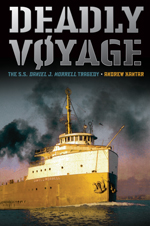By Eric Freedman
Nov. 30, 2009
LANSING — The Edmund Fitzgerald is the best-known of the Great Lakes’ doomed ships, but the freighter’s demise with its entire crew off Whitefish Point in the Upper Peninsula is by no means the state’s only such maritime disaster.
Andrew Kantar, a Ferris State University professor, tells another such story, that of the ill-fated freighter Daniel J. Morrell. It sank in 1966 off the tip of the Thumb in Lake Huron, northwest of Harbor Beach.
“Each of the Great Lakes has its own tragic history, and Lake Huron’s violent moods have become legendary,” Kantar writes in “Deadly Voyage: The S.S. Daniel J. Morrell Tragedy” (Michigan State University Press, $16.95).
Like the Edmund Fitzgerald, the Morrell went down in a brutal November storm.
Unlike the Fitzgerald, there was a survivor .As the ship sank, four shipmates made it onto a life raft, but Dennis Hale was the only one to live through the 38 hours it took before a Coast Guard rescue helicopter spotted the raft.
Twenty-six bodies were recovered. Two others were never found.
“All that was left were the families, the fathers and mothers, wives and children, sisters and brothers. It was a human wreckage of loss and emptiness,” Kantar says.
Related mashup: Shipwrecks of the Great Lakes
Eric Freedman reports for Capital News Service
© 2009, Capital News Service, Michigan State University School of Journalism. Not to be reproduced without permission.

To both Davids:
An even more interesting story and mapping project would discuss and illustrate the similarities of the sinkings of the Bradley, the Morrell and the Fitzgerald. Someone should address the question, why do the ship owners and the Coast Guard permit these voyages in November? None of these bulk carriers are seawothy at this time of year. The owners’ interests in the ships are insured, but neither the owners nor Coast Guard are held accountable for the loss of lives. To me, these are cases of recklessness for the sake of profits.
The website that was featured in the Monday Mashup for November 30 was a student project for a GIS Workshop I taught in the Department of Urban and Regional Planning at the University of Wisconsin-Madison last spring semester. Danny Bera developed the website using data sources he could find that identified a latitude and longitude for Great Lakes shipwrecks. One source was the Wisconsin Shipwrecks website (www.wisconsinshipwrecks.org/). He found another source for Lake Erie shipwrecks. Danny describes his methods in this blog post (http://urpl590mashups.wordpress.com/2009/05/07/shipwrecks-of-the-great-lakes/). Students only had a few weeks in class to work on their project. I noticed that Danny’s mashup didn’t work too well for me in Internet Explorer 8, but displayed OK in Firefox, Safari, and Chrome. I work as a GIS Specialist at the University of Wisconsin Sea Grant Institute and currently have a project with the Great Lakes Observing System to hold workshops to show people how to develop their own Great Lakes mapping mashups (http://glosworkshops.wordpress.com/).
Sorry, I guess I assumed it was Lake Huron because of the location of your post.
Regardless, the Bradley sounds like a vessel that the University of Wisconsin class should have plotted – I don’t know their criteria – and worthy of a book of its own.
Just for the record, David, the Bradley sank in Lake Michigan. Although thousands of shipwrecks have occurred in the Great Lakes, the sinking of the Bradley is notable because (1) it is contemporary in the sense that many of the crew’s families and friends are still alive, and (2) most of the crew were from Rogers City, Michigan.
Jim,
As noted in the mashup story, it comes from a source other than Echo. It was a class project at the University of Wisconsin-Madison. For whatever reason, it does not indicate any shipwrecks on Lake Huron. Maybe they didn’t have enough classmates to cover all of the lakes. You’ll note that the story indicates that there are more than 4,000 shipwrecks, but that this project catalogs 120.
The Deadly Voyage review does not mention the Bradley because the book is solely about the Daniel J. Morrell.
I’m curious why neither your story nor your map of shipwrecks includes the limestone carrier S.S. Carl D. Bradley, lost in 1958.
Pingback: MONDAY MASHUP: Shipwrecks of the Great Lakes | Great Lakes Echo